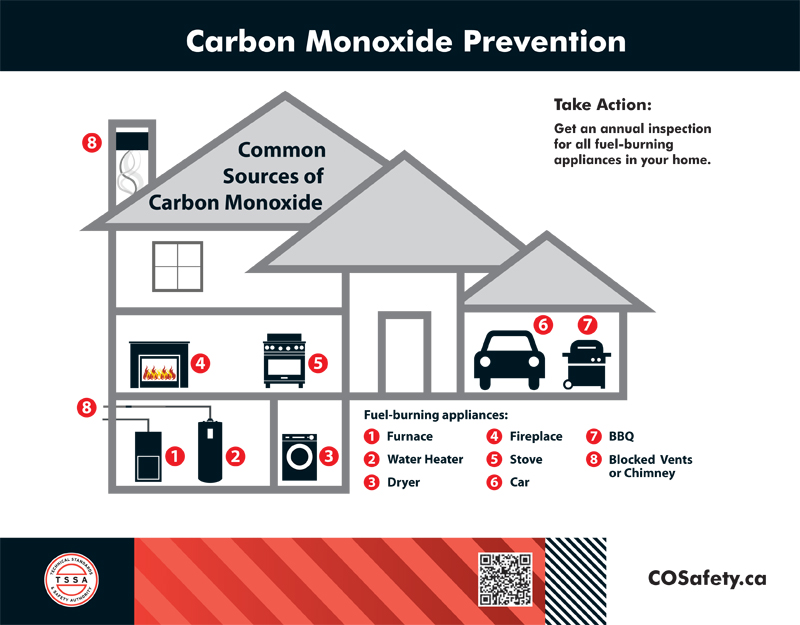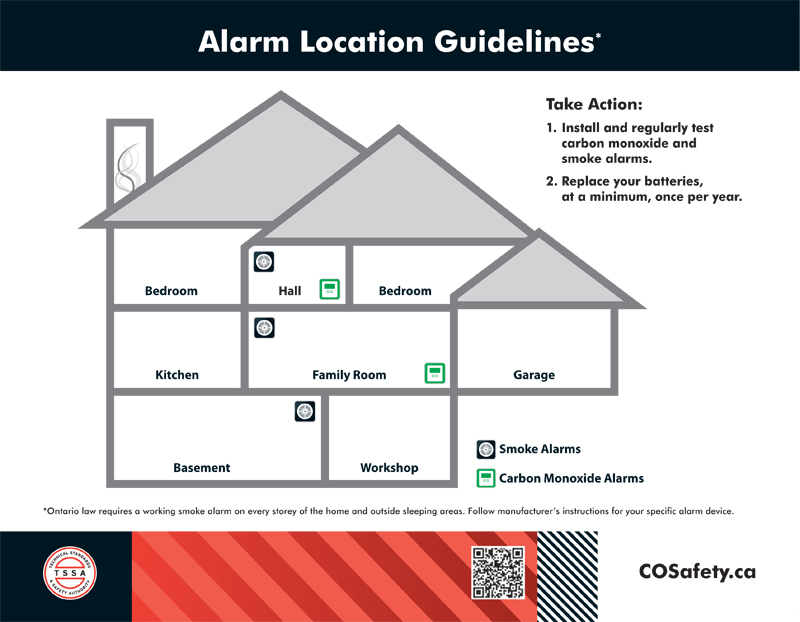1. Some information I have read tells me to evacuate immediately in case of fire. Other information says that I will be safer if I stay in my suite. Which is correct?
To go or to stay, the decision is yours. Each option involves a major commitment on your part. Your choice will depend on the circumstances at the time of the emergency. You should understand the consequences of this important decision. Most of the time, the best thing to do in a fire is leave the building as soon as possible. If you let this opportunity pass, you must be prepared to protect yourself from smoke and other effects of fire until you are rescued or told by the fire department that it is safe to leave. This may take a long time and the conditions in the building may deteriorate.
Do not try to leave your suite a long time after the fire alarm has sounded. The longer you wait to evacuate, the more risk there is that heavy smoke and heat will have spread into the stairways and corridors. Your chances of survival are significantly reduced. The following information will help you to make the right decision and to develop a personal fire emergency response plan ahead of time.
When should I go (evacuate the building)?
Evacuation is appropriate under any of the following conditions:
- As soon as possible when you hear the fire alarm or discover a fire. The earlier you leave, the better are your chances of getting out safely no matter where you are located in relation to the fire area. It is extremely rare for stairways and corridors to be contaminated by smoke in the early stages of a fire. Proceed as quickly as possible to the outside.
- When the fire is in your suite. You are in immediate danger and should ensure that everyone who is in your suite leaves with you. If you have physical limitations, plan ahead to ensure that you can get the assistance you need to evacuate quickly. Close the suite door behind you. Activate the fire alarm system and warn other residents located on your floor as you exit the building. Call the fire department via 911 when it is safe to do so.
- When the fire is on your floor or the floor below you. You are at high risk and should evacuate as quickly as possible if you have reason to believe that the fire is on your floor or on the floor immediately below you. Activate the fire alarm system (if the bells are not yet ringing) and warn other residents located on your floor as you exit the building.
When should I stay in the suite?
Remaining in the suite is appropriate under any of the following conditions:
- If you encounter smoke in the corridor on your floor. This may be an indication that the fire is in an advanced stage or is located on your floor. If you cannot safely reach an exit stairway, return to your suite as quickly as possible. Take actions to protect yourself from smoke. Call the fire department via 911 and provide details of your situation.
- If you encounter smoke in the exit stairs. The fire may have breached the stairway enclosure. Do not travel through smoke. Do not go to the roof. Re-enter the floor area immediately. If the corridor is free of smoke, try an alternate exit stairway. Otherwise, seek refuge in a suite on that floor as quickly as possible. Take actions to protect yourself from smoke. Call the fire department via 911 and provide details of your situation.
- If instructed to remain in the suite by fire department personnel handling the fire emergency. Attempting to evacuate at this stage may expose you to smoke unnecessarily and may impede fire fighting operations. If you are located on the fire floor or on the floor immediately above the fire floor, you are at high risk and may require rescue. Take actions to protect yourself from smoke. Call the fire department via 911 and provide details of your situation.
- If you are physically unable to use the stairs. Take actions to protect yourself from smoke. If you are located on the fire floor or on the floor immediately above the fire floor, you are at high risk and may require rescue. Call the fire department via 911 and provide details of your situation.
2. What else can I do to prepare myself before a fire emergency occurs?
Become familiar with the fire safety features provided in your building. For example, the effects of fire will be significantly reduced in a fully sprinklered building. This is an important consideration if you are unable to use stairs to evacuate the building during a fire emergency (e.g. physical disabilities, medical condition, etc.). Learn the location of the exit stairways and practice using them. Know which floors you can use to cross from one stairway to another.
Familiarize yourself with the fire alarm signal. Identify the location of fire alarm manual pull stations and read the instructions about how to operate them. If your building has a voice communication system, learn how it will be used by supervisory staff during an emergency.
Get a copy of the fire emergency procedures from your building management and read them carefully. Emergency procedures will be outlined in the building's approved fire safety plan. Keep this material in a prominent place and review it periodically.
Contact your fire department for more information or to request a fire safety presentation for all residents.
3. How can I identify the location of a fire when I hear the fire alarm?
In some buildings, the fire alarm system may have different tones (evacuation and alert signals) which will assist you to identify when immediate evacuation is required for your floor. If the building is equipped with a voice communication system, supervisory staff may be appointed to provide information on the location of the fire to the building occupants. Find out if these features apply to your building by becoming familiar with the building fire safety plan and emergency procedures as discussed above.
4. What actions can I take to protect myself from smoke entering the suite during a fire?
The following steps can be taken to protect yourself from smoke entering the suite during a fire emergency:
- Use duct tape (masking tape may also be effective) to seal cracks around the door to your suite and place wet towels at the bottom. Seal vents, air ducts and other areas where smoke is entering the suite in the same manner.
- If smoke is worse in one room (e.g. bathroom), close the door and seal off the room with tape and wet towels as noted above.
- If the suite fills with smoke, move to the balcony (if you have one) and close the doors behind you. Take a cordless or cellular phone with you if available. Call the fire emergency number and provide details of your situation. Also, take warm clothes or blankets if the weather is cold.
- If you do not have a balcony, go to the most smoke-free room, close the door and seal it with tape and towels. Open the window for fresh air but be prepared to close it again if this makes the conditions worse. Never break the window to get fresh air or you will not be able to seal it off if conditions change.
- Keep low to the floor where the air is cleaner.
Make sure that you have a roll of duct tape readily available. Duct tape can be purchased in most hardware/dollar stores.
5. I have read that most people die trying to evacuate during a fire. Is this true?
Experience shows that people who evacuate in the early stages of a fire can safely reach the outside. Most people die because they attempt to leave the building through smoke-filled corridors and stairs in the advanced stages of a fire. Although the conditions are different for each fire, this could occur as early as 10 minutes after the start of the fire.
If you made the decision to stay in the suite during the fire emergency, do not change your mind and attempt to evacuate later. Please refer to the situations noted above for details of when evacuation is and is not appropriate. If you encounter smoke during evacuation, look for an alternate route that is clear of smoke, return to your suite or seek refuge with other occupants on the nearest floor. Do not use the elevator for evacuation and never go to the roof since it is not designed as an exit.
6. What else should I know?
Many people are reluctant to evacuate unless they are certain that there is a real fire. This problem is made worse by nuisance alarms. Remember, a real fire grows for every minute that you delay and you may lose the only opportunity to evacuate safely. For this reason, all occupants who are able should begin evacuation procedures immediately upon hearing the alarm. If you made an initial decision to stay in your suite when a fire emergency occurs, do not attempt to evacuate in the advanced stages of the fire. You cannot outrun the effects of fire and smoke and will be placing yourself in extreme danger.
Each suite is designed as a fire compartment and will afford you a degree of protection during the fire emergency. However, smoke spread into your suite is very likely, so be prepared to protect yourself from smoke for the duration of the emergency. This may be a long time.



